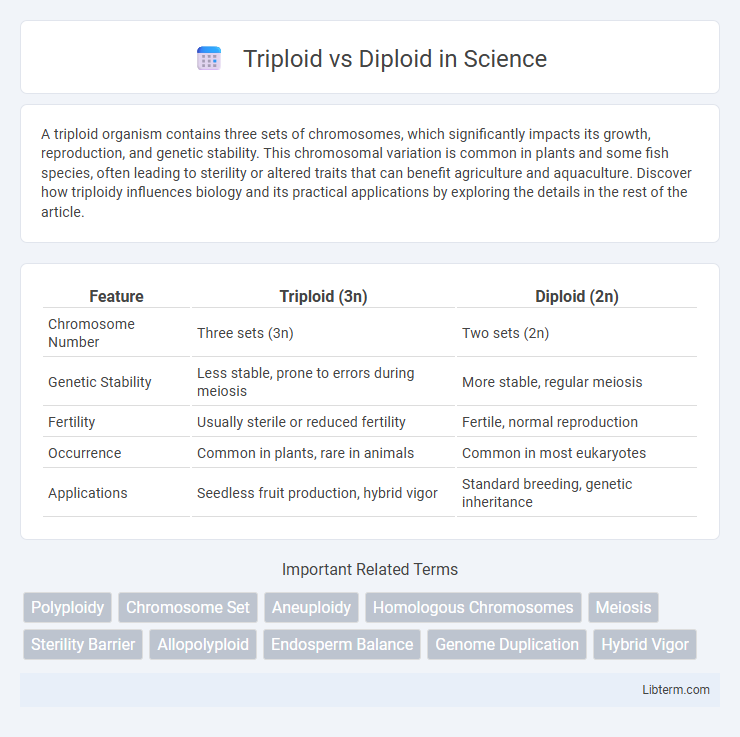A triploid organism contains three sets of chromosomes, which significantly impacts its growth, reproduction, and genetic stability. This chromosomal variation is common in plants and some fish species, often leading to sterility or altered traits that can benefit agriculture and aquaculture. Discover how triploidy influences biology and its practical applications by exploring the details in the rest of the article.
Table of Comparison
| Feature | Triploid (3n) | Diploid (2n) |
|---|---|---|
| Chromosome Number | Three sets (3n) | Two sets (2n) |
| Genetic Stability | Less stable, prone to errors during meiosis | More stable, regular meiosis |
| Fertility | Usually sterile or reduced fertility | Fertile, normal reproduction |
| Occurrence | Common in plants, rare in animals | Common in most eukaryotes |
| Applications | Seedless fruit production, hybrid vigor | Standard breeding, genetic inheritance |
Understanding Ploidy: Triploid vs Diploid
Triploid organisms contain three sets of chromosomes (3n), while diploid organisms have two sets (2n), which significantly impacts their cellular function and reproductive capabilities. Triploidy often results in sterility due to irregular meiosis, making it common in seedless fruit varieties and certain fish species, whereas diploid organisms typically undergo normal sexual reproduction. Understanding the differences in chromosome number between triploid and diploid is critical for applications in genetics, agriculture, and evolutionary biology.
Key Differences Between Triploid and Diploid Organisms
Triploid organisms possess three sets of chromosomes (3n), whereas diploid organisms have two sets (2n), impacting their genetic stability and reproduction. Triploids often exhibit sterility or reduced fertility due to irregular chromosomal pairing during meiosis, while diploids typically undergo regular meiosis, producing viable gametes. The chromosome count in triploids leads to increased cell size and potential hybrid vigor, contrasting with the balanced genetic expression seen in diploids.
Genetic Composition: Triploid Explained
Triploid organisms possess three complete sets of chromosomes, totaling 3n, unlike diploids which have two sets (2n). This genetic composition results from the fusion of an unreduced diploid gamete with a haploid gamete, leading to unique cellular characteristics. Triploidy often causes sterility due to irregular meiosis, affecting reproduction and genetic stability.
Genetic Composition: Diploid Explained
Diploid organisms contain two complete sets of chromosomes, one inherited from each parent, resulting in pairs of homologous chromosomes essential for sexual reproduction. This genetic composition allows diploids to maintain genetic diversity through mechanisms like meiosis and genetic recombination. In contrast, triploid organisms possess three sets of chromosomes, often leading to challenges in meiosis and reduced fertility.
Natural Occurrence of Triploid and Diploid States
Diploid organisms, containing two complete sets of chromosomes, are the most common naturally occurring ploidy state in animals and plants, enabling stable sexual reproduction and genetic diversity. Triploid organisms possess three sets of chromosomes and often arise naturally through hybridization events or errors during cell division, such as nondisjunction during meiosis. Triploids frequently exhibit reduced fertility or sterility due to irregular chromosome pairing, making them less common in nature but prevalent in certain plant species and some fish through asexual reproduction or vegetative propagation.
Methods of Producing Triploid and Diploid Organisms
Triploid organisms are typically produced through methods such as the fertilization of diploid eggs by haploid sperm, induction of polyspermy, or temperature and pressure shocks applied during early embryonic development to prevent the extrusion of polar bodies. Diploid organisms, in contrast, arise naturally through the fusion of haploid gametes during sexual reproduction, maintaining two sets of chromosomes. Advanced biotechnological techniques like chromosome set manipulation and cell fusion are also employed to create or maintain specific ploidy levels in both triploid and diploid cells.
Advantages and Disadvantages of Triploids
Triploid organisms contain three sets of chromosomes, offering advantages such as increased size, sterility which prevents unwanted breeding, and enhanced vigor compared to diploid counterparts with two chromosome sets. However, triploids often face disadvantages including reduced fertility or complete sterility, potential developmental abnormalities, and challenges in reproduction that can limit their use in breeding programs. The balance between the enhanced growth traits and reproductive limitations makes triploids valuable in aquaculture and agriculture but less suitable for natural propagation.
Advantages and Disadvantages of Diploids
Diploid organisms possess two sets of chromosomes, providing genetic stability and enabling sexual reproduction, which promotes genetic diversity and adaptability. However, diploids have limited potential for rapid evolutionary change due to their balanced chromosome number, and they may be more susceptible to deleterious recessive mutations than polyploids. Compared to triploids, diploids generally exhibit consistent fertility and stable phenotypic traits but lack the seedlessness and hybrid vigor often found in triploid plants.
Applications in Agriculture and Aquaculture
Triploid organisms, containing three sets of chromosomes, are widely used in agriculture and aquaculture to enhance traits such as growth rate, sterility, and stress tolerance compared to diploid organisms with two sets of chromosomes. In aquaculture, triploid fish like Atlantic salmon are preferred for their sterility, preventing breeding with wild populations and improving biomass production. In agriculture, triploid plants such as seedless watermelons and bananas offer commercial value by producing larger fruit and reducing seed formation, thereby increasing market appeal and consumer satisfaction.
Triploid vs Diploid: Future Perspectives and Research
Triploid organisms, with three sets of chromosomes, exhibit unique genetic traits compared to diploid organisms, which possess two chromosome sets. Future research focuses on enhancing triploid crop varieties for improved yield, disease resistance, and stress tolerance, leveraging advanced genomic tools and gene editing technologies. These studies aim to optimize triploid breeding programs and unlock their full agronomic and ecological potential.
Triploid Infographic

 libterm.com
libterm.com